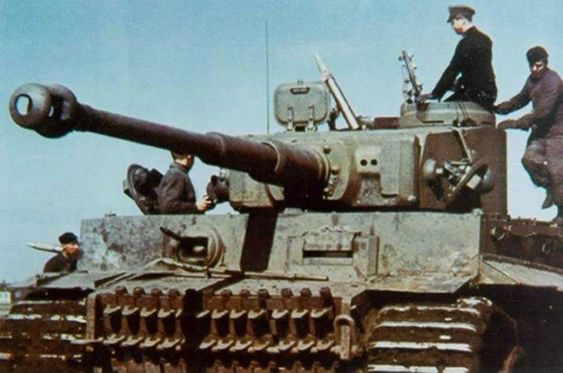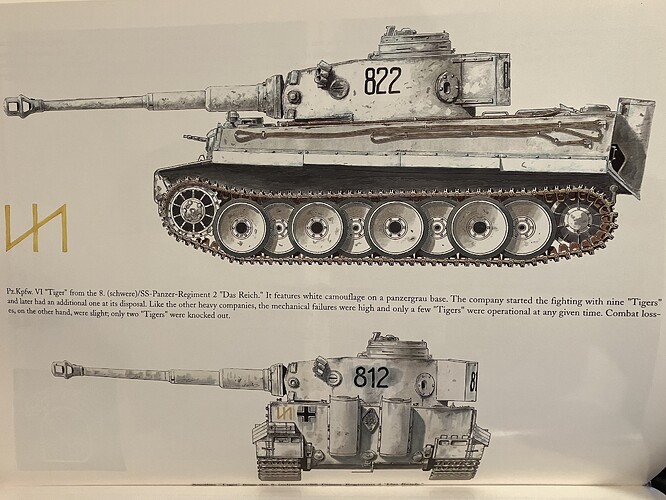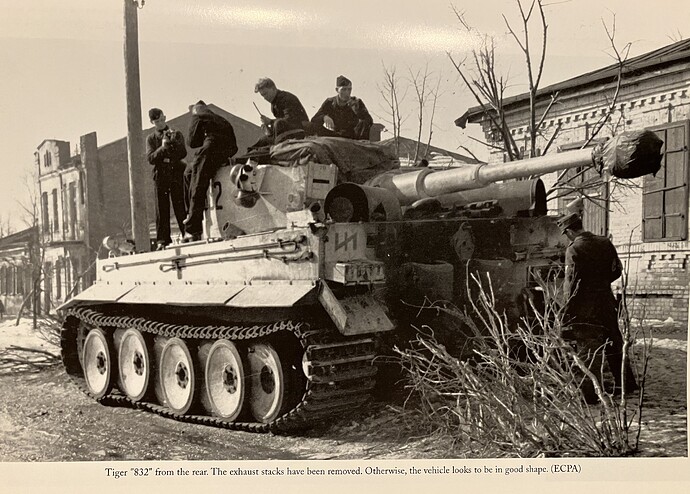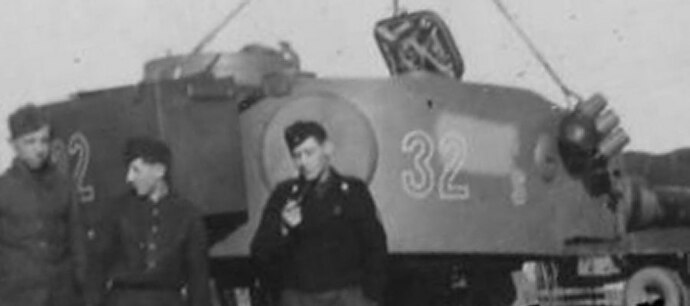In the third battle of Kharkov (Feb. '43) were there any Tiger tanks from Abt. 503 (or any Tiger units at all!) attached to Hausser’s SS Panzer Corps? When Tiger Abt’s were attached to various divisions, did they adopt that division’s sign, or did they retain their original Abt. symbol?
![]()
![]()
This maybe of interest.
Tiger 1 Early, Battle of Kharkov
"Production of the new Tiger tanks ramped up at the end of 1942. At first, they were issued only to the Heavy Tank Battalions created for them. But political maneuvering resulted in the addition of Tiger companies to three existing Waffen-SS divisions, and to the Army’s Grossdeutschland division. All four of these units participated in the Kharkov operation."
Yeah…I’ve read that Abt 503’s Tigers (or parts of) were sent to help in the Kharkov battle. But were they already an SS unit, or merely attached to Das Reich for the battle…as I believe Tiger units were still independent battalions. 503’s unit symbol was a small tiger head in a circle…did they switch that to Das Reich’s “Wolfsangel”? A few months later during operation Citadel, they seem to have been fully integrated with Das Reich, and used a temporary unit symbol of a sideways E.
![]()
![]()
Das Reich Tigers, The Battle of Kharkov, Winter 1942-1943, Jean Restayn, J.J. Fedorowicz Pub., page 204. There are Leibstandarte, Totenkopf and Grossdeutschland color plates of Tigers as well as various photos in this 409 page volume.
I found this in the meantime: https://digitalcommons.liberty.edu/cgi/viewcontent.cgi?article=5136&context=doctoral A pretty long read, but answers most, if not all, my questions.
![]()
![]()
Everybody RELAX!! ![]() I found the exact info in Wolfgang Schneider’s "Tigers in Combat ll! Plus some very helpful info from David Byrden,
I found the exact info in Wolfgang Schneider’s "Tigers in Combat ll! Plus some very helpful info from David Byrden, ![]()
![]()
![]()
![]()
![]()
The 503rd were located around Rostov at the time of Third Kharkov. They moved to the Kharkov area late in April 1943. I have seen no evidence that they integrated with Das Reich or gave them any Tigers.
Tiger units that participated in the Kharkov battle were Das Reich, Totenkopf, LSSAH and Grossdeutschland. Each unit had only a single Tiger company with 9 or 10 Tigers.
David
The illustration and text in the Restayn book have some problems.
Das Reich “started fighting” with 10 Tigers. But on 25 February one was accidentally submerged and was out of action for weeks.
The base colour of these tanks was not grey, it was a brown colour RAL 8000.
The name of the grey colour for tanks was “Dunkelgrau”, not “Panzergrau”.
The illustration shows the tank’s starter handle stored on its rear wall. In fact Tigers of this era had no storage clips for the handle in that place.
The lifting jack for the tank is not drawn on the illustration.
David
The Tiger 1s were delivered to the Reich in RAL 7021 by Henschel, as W. Schneider and other authors have researched. There is no paperwork from the Henschel Archives or HWA etc. suggesting otherwise. All Tigers sporting RAL 8000 seems fictional.
Ah, so we have a dispute.
The claim that these Tigers were painted in a “tropical” scheme is made in “Germany’s Tiger Tanks volume 1”, by Doyle and Jentz, page 190.
Now, I don’t know where they got that information, but they are regarded as the best Panzer researchers in the world, and - which is important - they derive their information from original documents and surviving vehicles only. They do not repeat information from secondary sources.
I will ask Mr. Doyle if he can remember where he got the information. It’s not an unexpected or impossible claim, though, because - as many researchers have found in recent years - “tropical” colours were allowed on other vehicle types on the Ostfront, following requests by the troops. In fact, colour photographs have been found to support that.
Now, to examine your position. You say that W. Schneider researched the original colour of these Tigers to be Dunkelgrau.
W.Schneider is the author of the “Tigers in Combat” volumes. I have conducted research into some specific Tiger units, and I find that his work contains errors. Furthermore, his errors often amount to printing speculation as if it were fact - something that historians should avoid.
Let us examine a specific section from T.I.C.1, the “Tigers in detail” chapter at the beginning. Let’s go through the section that deals with s.Pz.Abt.501 in Africa - a topic that has been thoroughly researched via hundreds of photographs, among other evidence.
Schneider says their Tigers were delivered without mudguards, and the 501 added mudguards, which is true. But then he says
“These front mud guards, made of curved metal sheets, were significantly smaller…”
He is mistaken. It is the SIDE mud guards that were added. These Tigers did have FRONT mudguards on delivery.
He is mistaken to describe the guards as “curved”. They were flat with a single fold.
Then he describes the turret bin of these same tanks as as “home made”. Well, we don’t know where it came from, but since identical bins were used by the 502, LSSAH, Grossdeutschland, Totenkopf, and Das Reich, it seems that a manufacturer was the source. Probably the same manufacturer who later produced the standard turret bin.
He says that “three tanks [of the 501] later transported to Tunisia…did not have the MP flap on the right”. But there is zero evidence that those three Tigers reached Tunisia. They stayed in Sicily by all accounts. All Tigers that we see in Tunisia without the MP flap are marked as belonging to the 504.
And now it gets really interesting. He lists the original turret numbers of 1. and 2. company as:
“100, 200, 111, 112, 121, 122, 131, 132, 141, 142”
“211, 212, 221, 222, 231, 232, 241, 242”
But six of those numbers are false. They never existed as Tiger numbers in the 501 (some of them were Panzer III numbers).
It’s not possible that Schneider saw these numbers in any photograph of a 501 Tiger, so where did he get them?
Then he says that two Tigers were lost in January. He says they were “121 and 142”. That is certainly wrong - we have plenty of photographs of those two Tigers, alive and well, weeks later. The first losses were actually 122 and 231, and we have photographs of the wreckage of both. We even have a detailed British report with location, date and photographs concerning “231”. The numbers printed as fact by Schneider are unquestionably wrong.
He says that a reorganisation happened as a result of those losses, eliminating the 4th platoon. Well, we can’t say how the Tigers were grouped after this, but they were not renumbered. Tigers 141 and 142 were still active weeks later.
Then, he talks about a second reorganisation, with the Tigers being renumbered with “7xx” and “8xx” digits because they were folded into 10 Panzerdivision. That’s not what happened. The Tigers of 1 company were not renumbered at that time. They were 7 company on paper, but still bore their old 1 company numbers when they went into action at Ochsenkopf. We can see this in photographs.
The 2nd company DID renumber their Tigers when he claims. But they simply changed their leading digit to “8”. There is no evidence of the reorganisation that he claims. And yet he prints a new list of “8xx” numbers for this supposed event, and (once again) half of the numbers on that list are wrong. We never see them on Tigers of the 501. But we DO see numbers that are not on his list.
Moving on to the aftermath of Ochsenkopf, Schneider says the Tigers were reorganised. That is supported by the evidence. But he thinks this is the third reorganisation, while evidence suggests it was the first.
He doesn’t attempt to list the Tiger numbers this time, but he explictly says that Tiger “712” was formerly “812”. That’s not true. It was formerly “81”. There was never an “812”.
So, after that long catalogue of mistakes that can’t possibly be supported by any evidence he may have seen, I am not inclined to believe what he says about colours. Did he give a source?
David
Let me show you a piece of evidence and ask if you can explain it.
It is not easy to find photographs of Tigers from these four companies where we can deduce their original colour. Three of the companies covered their tanks in whitewash camouflage, apparently before any photos were taken. The other company - 13 co. Grossdeutschland - apparently didn’t paint their Tigers during the campaign, but unfortunately most photographs from this time show them against a background of snow. The brightness contrast is such that they may appear darker than they are.
However, we do have this photograph…
The markings imply that it’s a GD Tiger. Combined with the non-standard turret bin, they imply that it’s from the original batch, which is our topic.
The tank seems to be relatively clean. It has had no whitewashing or overpainting except for an obvious change to its turret number.
The turret bin is significantly darker than the tank, and the man’s black uniform is darker than the turret bin.
If this is a Dunkelgrau Tiger, as you claim, then what colour is the bin?
David
David
Even if W. Schneider made some mistakes … according to you … so have J&D and others but that is not the point here.
What W. Schneider ans other authors did is to look through the archives, evaluating original documents and pursued a more scientific and academic approach of information available.
The examples you list do not really prove anything except a status of that moment the pictures you’re referring too. Since you are relying on fotos you have only that trail of those events.
All the turret numbers you listed here and the conclusions you draw are just a “speculative” since W. Schneider does mentions his sources … see “Tiger der Division Das Reich”.
The arguments you present here also fall short by avoiding the actually topic by distractions to discredit W. Schneider credibility.
Besides, the value of a specific turret number, existed or not, proves what exactly ?
BTW … how many books have you written and/or researched in a proper academic fashion ?
Your last comment just shows your inability to support your own claims.
Since everybody else is wrong … on what ever issue … then you must be right on everything you claim.
So where is your proof ? A inconsistent history of B&W fotos … open to all sorts of manipulation since you don’t possess the original slides ?
Have you ever seen the Henschel “Werkstatt” logs from Oct. 1942 -Feb. 1943 ?
Have you ever seen the Henschel shipping manifests of the same period ?
Have you ever seen any Henschel accounting records (Contracts / Invoices to the HWA) of that period ?
Has a curator of the Henschel Archives confirmed to you that only RAL 7021 was applied till early April 1943 and that no deviation from the contracts is documented or recorded ?
Do you possess any copies of such original document acquired before most of the archive was sold ?
Tiger 131 in Bovington, build in Feb. 1943 was delivered and RAL 7021 as we all know. Then please explain the logic within the production & procurement system to repaint a few Tigers to RAL 8000 … just to have them white washed … when the Tigers of the LSSAH and GD, also delivered around the same time keeps their RAL 7021 finish ?
A look at the shipment manifest from Henschel to the HZA /unit location might be an indicator ?
Your theories do not reflect any logic of actual HWA/HZA procedures at the time.
The military situation in Winter of 1942-43 is also not reflected in your claims.
Sure some Tigers could have repainted been at the HZA but why would they go through the burden / luxury of repainting vehicles which where already allotted to specific units of the eastern Front being hardly pressed at the time (Stalingrad)?
The fotos you evaluate are potentially just a little piece of the whole puzzle … not more and not less.
Christopher
David
You don’t have a clue what the color of the bin is and neither do I.
You claim the one thing is this so the other must be that without solid a benchmark of start your theory.
They even made a movie “City shades of grey” maybe that’s what we are seeing here … the bin could be a darker Grey or even Black … maybe even a Russian Green tone … or what ever else was at hand.
Chances are is a repaired or replacement bin in a darker color, there are many logical options why the colors differ. The tank therefor being in RAL 8000 isn’t the most logical option.
The only solid evidence of a GD Tiger we do have is this picture:

Please do compare the contrast of the Black uniform …
Christopher
You admit that W.Schneider “made some mistakes”.
Therefore we cannot take his word as gospel, when he says these Tigers were grey.
I’m not sure why you continued writing your post after making that admission? It’s “game over”.
You say that the turret numbers I posted are “speculative”.
No, they are not. They are clearly visible in photos.
And they are missing from the lists of numbers that W.Schneider published.
You ask “the value of a specific turret number”? It is proof that W.Schneider cannot be relied upon. He makes a guess at how the tanks were numbered, then he tells us they were numbered so. He doesn’t say “possibly” or “in theory” - he just writes the list and says “Here are the numbers”.
And photos disagree with him.
His statements about colour cannot be trusted for that reason.
Again I ask you, does he give a source for the colours? You gave us a book title. But don’t expect us to read 200 pages only to discover the book doesn’t mention colours at all.
And then you have more to say… not about Tigers, but about me. Which is off-topic and not interesting to the readers.
“how many books have you written and/or researched in a proper academic fashion ?”
Irrelevant question. How many actual Tiger tanks have you painted before they were shipped off to Kharkov? Zero, but you still talk about them.
You spend a full paragraph demanding my sources… when I ALREADY TOLD YOU where I got the information.
Then you tell us that LSSAH and GD Tigers were painted RAL7021. But that is not a premise that you can assume : that is the conclusion you are trying to draw. In fact I already posted a photo that seems to disagree with it.
Let me explain why you said that.
I don’t like to post guesses and assumptions, which a lot of people seem to do online.
Usually I will only bother to post when someone else makes a mistake and I KNOW that it’s a mistake.
Reading my comments, you will therefore find many of them are corrections to other people.
But that does not mean I have the attitude “everybody else is wrong”.
Most people are right, most of the time. I just don’t see the point of patting them on the back for it.
You then compound your error by making a logical fallacy.
The premise “everybody else is wrong” does NOT imply the conclusion “I must be right”.
David
![]()
![]()
Chances are is a repaired or replacement bin in a darker color
I should have mentioned this; photos of GD from this time period show that all of the Tigers they were using, had turret bins much darker than the tank itself. This is not a one-off repair.
You don’t have a clue what the color of the bin is and neither do I.
Correction: we don’t have a clue what the HUE is.
We both know that the bin is a lighter colour than the black uniform, and the tank’s turret is a lighter colour again. If the turret were Dunkelgrau, I doubt that it could be two stages lighter than black. And I would like some explanation of what colour comes between black and Dunkelgrau and is so very different to both of them, in terms of brightness.
The photo is consistent with the statement made by Doyle and Jentz.
David


